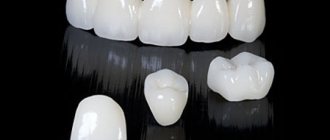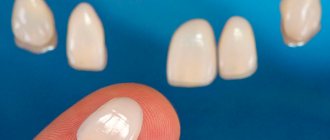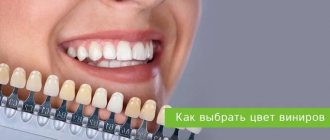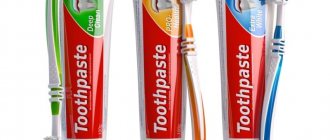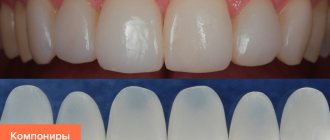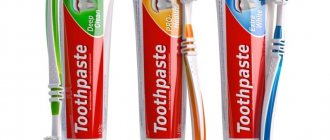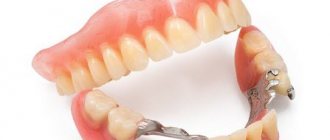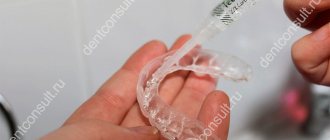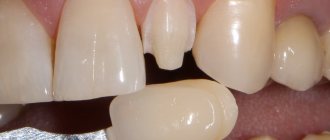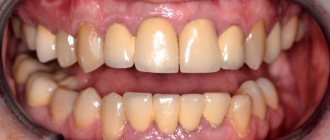Do you dream of a flawless Hollywood smile? Do you want your teeth to be perfectly straight and white, like those of Insta stars and celebrities? This is possible, and even for a very reasonable budget. At the 32 Dent clinic, you can completely restore your teeth using high-quality and modern veneers. Just a couple of visits to the dentist’s office - and you will get the same result that will pleasantly impress you and those around you!
Veneers are thin overlays 0.2 - 0.7 mm thick, which are fixed to the outer surface of their teeth using a special adhesive. They can also be called microprostheses, plates, prostheses, but the essence does not change. This is the most effective method in a couple of visits to the dentist to transform unaesthetic teeth into absolute perfection in color, shape and transparency!
This is interesting! The very first dental veneers appeared at the beginning of the 20th century in the USA, and they were intended for Hollywood stars (hence the phrase “Hollywood smile”). Initially, these were unnaturally white and rough in structure ceramic plates of impressive thickness, which made their teeth larger - it was visually noticeable that there were dentures in the mouth.
Modern designs are more advanced, but at the same time they look natural and aesthetically pleasing. You can easily verify this by looking at examples of the work of doctors at the 32 Dent clinic. The result will impress you!
Who is recommended for veneers and who is not?
In principle, any patient can get dental veneers if they have the funds and the desire. Most often, veneers are installed on teeth for the following reasons:
- not satisfied with the natural color of your teeth;
- there are stains or microcracks on the tooth surface that you want to disguise;
- if there are three (small distances a few millimeters wide);
- in cases where teeth are prone to increased wear at the edges;
- if there are minor orthodontic defects, for example, the tooth is slightly rotated, or mild crowding is diagnosed.
Note!
Even the most modern whitening technologies are not able to give tooth enamel such impeccable whiteness as microprostheses. That is why more and more patients are inclined to install veneers and make their dream of incredibly beautiful teeth come true! Like any restoration procedure, the installation of veneers has its contraindications. It will not be possible to install dental microprostheses if:
- the patient suffers from bruxism - otherwise, microprostheses will constantly break;
- when your teeth are loose and in poor condition, prosthetics will help here (possibly together with implantation);
- if the enamel thickness is insufficient or it is destroyed, then the microprosthesis will not hold;
- the teeth are naturally underdeveloped, too small - the structures simply will not be fixed on the surface;
- there are acute diseases of the ENT organs, problems with the heart and blood vessels, tumors, etc.
Relative contraindications are problems with bite and caries - these issues can be treated, and only after that you can work on the aesthetics of your smile.
Note! If a tooth has been restored by more than 60%, it has a large filling, and it is not advisable to install onlays on it. This can lead to subsequent destruction of the crown, and the patient will already spend a considerable amount on the installation of dental microprostheses. Perhaps in this case, prosthetics at the 32 Dent clinic will help.
Dental treatment with veneers and crowns
Patients often have a question: how to treat teeth under veneers and crowns, because they are covered with artificial material from the front part/on all sides. The answer is simple: there are no difficulties in this. Modern dentistry provides for dental treatment without removing the veneer/crown with complete preservation of the structure. Treatment of a tooth under a veneer/crown is not much different from standard endodontic treatment.
Using a special tool, the doctor drills a small hole in the crown, through which access to living tissue is provided. Modern treatment methods even provide for the possibility of refilling the canals if necessary. At the final stage of treatment, the access in the crown is closed with a filling, the same one that is used to treat teeth without structures. It does not matter what material the crown is made of. Thus, the patient does not incur additional expenses that are inevitable when removing a crown and then reinstalling it.
If the patient has problems with the unit on which the veneer is installed, the treatment is even simpler, since the back of the tooth is not affected and access to living tissue is free.
What you need to be prepared for when deciding to install veneers on your teeth
Unfortunately, patients are not always aware of all the points associated with these structures.
- The crown must first be ground. In most cases, when installing veneers, the enamel must be prepared (remove a microscopic layer) - otherwise, the overlay will stick out and provoke an unattractive effect. But in this case, you can choose an alternative - ultra-thin lumineers, which are attached to the enamel without pre-turning, but at a price - they are much more expensive than conventional onlays.
- Not for life! When deciding one day to put veneers on your teeth, be prepared that in a few years you will have to replace them with new ones. Even the best pads won't last a lifetime. If we are talking about composite veneers, they will have to be replaced after 5 – 7 years.
- Beware of caries! Unfortunately, even the best and well-installed structures do not guarantee that caries will not develop under them. Therefore, experts recommend that patients with veneers monitor their oral hygiene even more carefully and undergo regular preventive examinations in the clinic.
- Pleasure is not cheap. This is not only about the beauty of teeth, but also about the need to invest periodically. So, for example, if one pad breaks or comes off, it will have to be replaced with a new one, which also costs money. However, by investing in your health and beauty, you get much more!
What types of veneers are there? Which is better to choose?
Conventionally, three groups of restoration structures for teeth can be distinguished, if we take into account the specifics of their installation:
- Direct – plates that are installed directly in the dentist’s chair. The specialist first grinds the tooth, after which he applies the composite material layer by layer - by analogy with artistic restoration. As a result, it is possible to obtain a beautiful “new” tooth in shape, color and transparency. The main advantage of direct overlays is their price. The main disadvantage of direct structures is that over time, the composite material still darkens, turns yellow, and the aesthetics are no longer the same.
- Indirect - onlays that are made in advance using impressions taken from the patient’s ground teeth. After the plates are ready, they are tried on the prepared teeth, and then they are fixed using an adhesive composition. While the veneers are being produced in a laboratory, special temporary structures are placed on the patient’s teeth (similar to temporary dentures). The main advantage of indirect solutions is that they are more durable and do not change their color and transparency throughout their entire service life. The main disadvantage of indirect overlays is their high price compared to composite plates.
- Semi-direct – a combination of the two technologies listed above. First, impressions of the patient’s teeth are taken, and new onlays from composite material are made in the dental laboratory. The main advantage of semi-direct veneers is that their fixation to the teeth is considered more reliable. The main disadvantage of semi-direct options is that composite linings still last no more than five years; over time, they will have to be replaced with new ones.
As you can already understand from our examples of clinical cases, dentists distinguish two categories based on the material of manufacture:
- Composite – dental onlays made of filling composite. In some cases, they can be installed without first grinding down your tooth. For example, when there are microscopic cracks in the enamel, or the patient is not satisfied with the shade of the tooth enamel. A thin layer of composite material will mask these moments and allow you to achieve ideal whiteness of your teeth. There will be no visible transitions from the composite composition to the native tissues of the tooth enamel.
- Ceramic – dental plates made from dental ceramics. More advanced solutions in terms of creating ideal tooth shapes. They will help to align and achieve ideal anatomical proportions of teeth, since the structure of the material is as close as possible to the characteristics of natural enamel. At the same time, the price of ceramic analogues is three or even five times higher than the price of classic composite overlays.
Which veneers are best to choose? The question is strictly individual. To answer this, the dentist must:
- assess the condition of the patient’s teeth;
- see the condition of the jaw and exclude serious orthodontic abnormalities;
- find out the goals pursued by the patient who wants to install linings from a particular material;
- roughly be aware of the allocated budget for smile restoration.
It is important! In case of severe curvature of the teeth or pathologies of the jaw, guilt is undesirable. But the patient can always straighten the teeth first and then install veneers to get the picture of their dreams.
As practice shows, ceramic structures are still more preferable. Firstly, this is quality that will prove itself within 20 years. Secondly, it is reliable; teeth will not darken from coffee or cigarettes in a year. Thirdly, if you calculate the budget for installing composite systems every 5 years, then installing ceramic veneers is more profitable from a financial point of view.
Among the most common ceramic veneers, we note 4 directions:
- Zirconium dioxide dental veneers – the main part is made of zirconium alloy, and the top is coated with dental porcelain. They are considered one of the most reliable and durable, but in terms of their tint range and transparency they may be inferior to glass ceramic linings;
- Made from glass ceramics – so-called metal-free plates, which are made in a dental laboratory from pressed glass ceramics. The most popular plates you may have heard of are E Max CAD and E Max Press;
- Porcelain dental veneers are the “gold standard” of designs that combine optimal price and quality. Dental porcelain is the same ceramics, but with characteristics closer to natural enamel;
- Ultra-thin or lumineers are dental onlays approximately 0.02 millimeters thick. They are considered the thinnest, their installation does not require preliminary grinding of the enamel, but their cost is several times more expensive than classic porcelain ones.
How is a ceramic veneer different from a lumineer?
By and large, Lumineers are the same ceramic veneers, but more matte, less able to convey the transparency and shine of the enamel, which, in my opinion, leads to a less aesthetic result. The statement that there is no need to prepare before placing lumineers on the teeth is also incorrect. Therefore, I personally do not see the point in lumineing, the quality of which does not suit me, and I prefer to work with classic ceramic veneers.
Installation of veneers: features, important nuances that the patient should know better about
The indirect method involves 3 steps:
- Preparation. First, the tooth enamel is ground down a few tenths of a millimeter - a thin layer of enamel is removed. Then the dentist makes impressions of the patient’s also prepared teeth, after which he covers them with special protective caps - for the period of time while the veneers are produced in the laboratory;
- Visualization. Computer model with “before” and “after” effect. In a 3D program, the dentist creates a virtual model of teeth and clearly demonstrates how it was and how it will be after. The picture is usually impressive and motivating;
- Installation of veneers - your new perfect smile is ready! The dentist fixes the onlays on the tooth enamel, and the patient evaluates the final result.
Installation of microprostheses using the direct method also involves 3 steps:
- Preparation. The dentist removes a small layer of tooth enamel for the patient and prepares the teeth for further restoration;
- Installation of composite structures. Layer by layer, the dentist distributes the composition over the surface of the enamel, while each of them is illuminated with a lamp to “seal”;
- Polishing and finishing to perfection. The enamel surface is carefully polished, the shape of each tooth is brought to perfection.
Price question: how much does it cost to install veneers?
As we already said, dental veneers are not cheap, but they are worth it!
Approximate cost of microprostheses:
- Composite ones are the most budget-friendly. The cost of one unit is approximately 7 thousand rubles;
- Ceramic microprostheses, which are manufactured in a dental laboratory, cost approximately 20 thousand rubles per unit;
- Ceramic dental veneers made at the 32 Dent clinic will cost the patient about 15 thousand rubles per unit;
- Lumineers are the most expensive - from 50 thousand rubles per unit.
How can you save on installing veneers?
There are two ways to go. Place veneers on individual teeth for the patient. For example, for 10 units of the upper jaw - provided that your teeth are in good condition. You can whiten the enamel of your teeth, but the result will not always be perfect.
There is also a solution to take advantage of the favorable conditions of clinics. Thus, 32 Dent dentistry regularly holds promotions and special offers for the installation of veneers. There are opportunities to install dental microprostheses at a discount of 15% to 50%. The quality of work is at the highest level, as are the guarantees.
Ceramic veneers without turning
Some doctors are disingenuous when they say that the installation of composite veneers, unlike ceramic ones, requires virtually no preparation. In fact, it is impossible to install composite or ceramic veneers without grinding. However, the higher the quality of the specialist’s work, the less impact there is on the teeth. The teeth are processed only with the help of high-quality German burs, precisely centered and having a strictly specified grain size. Moreover, the installation of ceramic veneers is carried out using a high-tech dental microscope. Thus, through the use of modern technologies and materials, we are able to achieve minimal, but very high-quality tooth processing, literally within the enamel. Thanks to this innovative approach, the plate fits perfectly to the prepared surface, which significantly increases the service life of ceramic veneers.
Hit list of questions and answers about veneers
Do veneers ruin your teeth?
Answer: teeth are spoiled by carious lesions, neglect of hygiene rules, lack of regular visits to the dentist, poor nutrition, and bad habits. Veneers, made of first-class material and installed by a professional dentist, on the contrary, protect the enamel from harmful external influences.
Is it painful to install?
Answer: no, it doesn't hurt. The procedure is performed under local anesthesia in a comfortable environment. It is important! There is no need to remove dental nerves during installation.
How long will it take to install?
Answer: on average, from 5 to 14 days or 2 to 3 visits to the dentist’s office.
Dental clinic "32 Dent" specializes in the installation of dental veneers on a turnkey basis. Both budget-class microprostheses and premium solutions are available, including patented American lumineers. Schedule an initial consultation with your doctor to choose the best path to restoring your smile with veneers. The smile will be beautiful and at the same time natural. Take action!
Author's veneers at NKclinic
Few people in the modern world can say that they are satisfied with their natural smile. Some defects, such as malocclusion and underdeveloped teeth, are congenital. During life, teeth are also exposed to negative environmental influences, including harmful industries, injuries and bad habits, which can lead to cracks, chips, and slight discoloration. Incorrect bite, without timely orthodontic correction, leads to increased tooth wear, which is a direct indication for reconstructive orthopedic dentistry.
For NKclinic specialists, making veneers is a responsible as well as creative process. At the same time, the finished product is inimitable and unique. Despite the large-scale introduction of digital technologies, doctors at our center exclude the use of template, standardized methods for manufacturing ceramic structures.
At NKclinic, the main principle of the work of the chief physician, Grigory Georgievich Kyalov, is to create teeth of natural beauty, taking into account the optical properties of hard dental tissues: light transmittance, brightness, transitional shades of color, like natural teeth. This makes it possible to emphasize your individuality, place the right accents and add charm to your smile.
The key to achieving maximum aesthetic results is individualized, multidisciplinary treatment planning. Often, in addition to the orthopedic stage, the patient needs surgical correction of the gingival margin, which allows the formation of the correct gingival contour. Get proper periodontal care.
Aesthetic and functional analysis of the dental system as a whole consists of a comprehensive study of each clinical case individually. This takes into account the structural features of the skull, the trajectory of the lower jaw, as well as facial features.
To achieve the most predictable and accurate results, we use digital technologies in combination with the practical and clinical experience and knowledge of our center’s professionals.
Orthopedic treatment planning:
- Medical photography to assess the aesthetic parameters of the patient’s face and determine individual anthropometric data.
- Creating 3D photographs of a face.
- Digital scanning, which, in combination with the manual skill of the doctor, allows you to obtain highly accurate three-dimensional digital models of the jaws and bite in a matter of minutes.
- 3D modeling makes it possible to compare medical photographs of a patient with digital models of the jaws, combined with computed tomography and 3D photography to predict the outcome.
- Digital modeling of teeth according to the patient's smile to achieve facial harmonization. The use of a virtual articulator allows you to build a physiologically correct bite.
- Making a 3D model on a 3D printer.
After this, our doctors make a mockup, i.e. transfer of a prototype of future orthopedic structures into the oral cavity.
At this stage, the design of future teeth is agreed upon with the patient, namely the color, shape, size and other nuances of the future smile.
This layout allows the orthopedist to prepare the teeth in such a way as to correctly convey the optical effects for maximum naturalness of the smile, as well as to easily install the ceramic structure in the oral cavity at the fixation stage, while maintaining the maximum thickness of the natural tooth tissues. Kyalov Grigory Georgievich individually selects materials for each specific case. Our goal is not to sell the most expensive technology. We work for high results and select the best solution for our patients.
Ceramic veneers are made from sintered ceramics, which has maximum aesthetic properties close to the properties of natural tooth enamel, therefore an important condition is the preservation of the enamel layer of the tooth.
NKclinic doctors work at the intersection of scientific and practical dentistry and art. Our approach will certainly be appreciated by people who want to achieve a truly unique smile.
